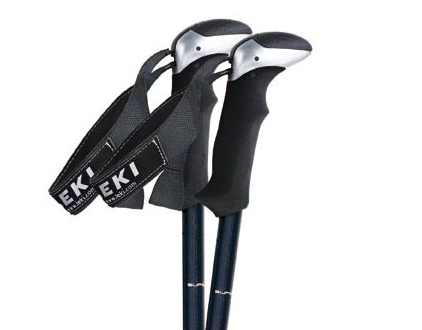By RYAN DIONNE
Hiking, mountain climbing, and testing trekking poles on snow, I have found that one thing that sets Leki apart from other manufacturers is the company’s ergonomic hand grips. They are comfortable no matter how they’re held. Leki’s high-end, lightweight Thermolite AERGON Antishock pole is no exception. The pair, which weigh a scant 16.2 ounces together, have molded foam grips and adjustable wrist straps.
Unlike other pole grips that are seemingly designed for flat trails or ascending, Leki’s are just as comfy descending steep trails as they are going up or trekking the flats. Each hand hold has a molded index finger notch and a shaped grip that makes for an ergonomic fit and a content hand no matter how long you’re hiking.

Further, the wrist straps can be adjusted for both small and large wrists — something many other poles can’t accommodate — and the quick-adjust system is easy to work on the trail.
When descending steep trails, the top of Leki’s Thermolite AERGON Antishock poles, which are oblong, are slightly convex to better fit in the palm of your hand. By turning the poles backwards and palming the top of them you get the needed support.
The 7075 aircraft aluminum AERGON Antishock poles also have a carbide tip that in my tests has trustingly gripped nearly any surface.
But the antishock technology left something to be desired. Compared to other high-end poles without the added feature, such as the Black Diamond Contour Elliptic Carbon, I found little benefit while on mixed-terrain trails.
While the Leki Thermolites cost $10 less than the BD Contour Elliptics — and weigh less, too — the inner spring and “elastomer” that gives the Lekis suspension did little for me when on mixed terrain. The springy absorption was not very noticeable on trails, but I could feel the difference when on pavement.
Another negative: Leki’s twist-lock system to tighten and adjust pole length is not the best. If I twisted them tightly, it was difficult to loosen them later if I had cold hands or was wearing gloves. On a recent trip, my wife and another female hiking partner couldn’t loosen them if I twisted them too tight.

Some people don’t adjust their poles throughout the day. But for me, when hiking I don’t use my poles all the time. That means I have to adjust the poles a handful of times each day, which got cumbersome with the twist-lock system. To the system’s credit, though, once adjusted, no matter how much weight I put on the poles, they didn’t loosen.
- Pros: Lightweight and strong; Ergonomic hand grips; Adjustable, comfortable straps; “Super Lock” system keeps extended poles in place
- Cons: Twist-lock system harder to adjust than other methods; Shafts vibrates considerably; Antishock technology did little on trails; High price
- Bottom Line: Leki’s Thermolite AERGON Antishock poles have comfortable grips and straps, but the antishock system did little for me in a test and the twist-lock tightening system is overdue for a change.
- MSRP: $140
- Contact: www.leki.com








